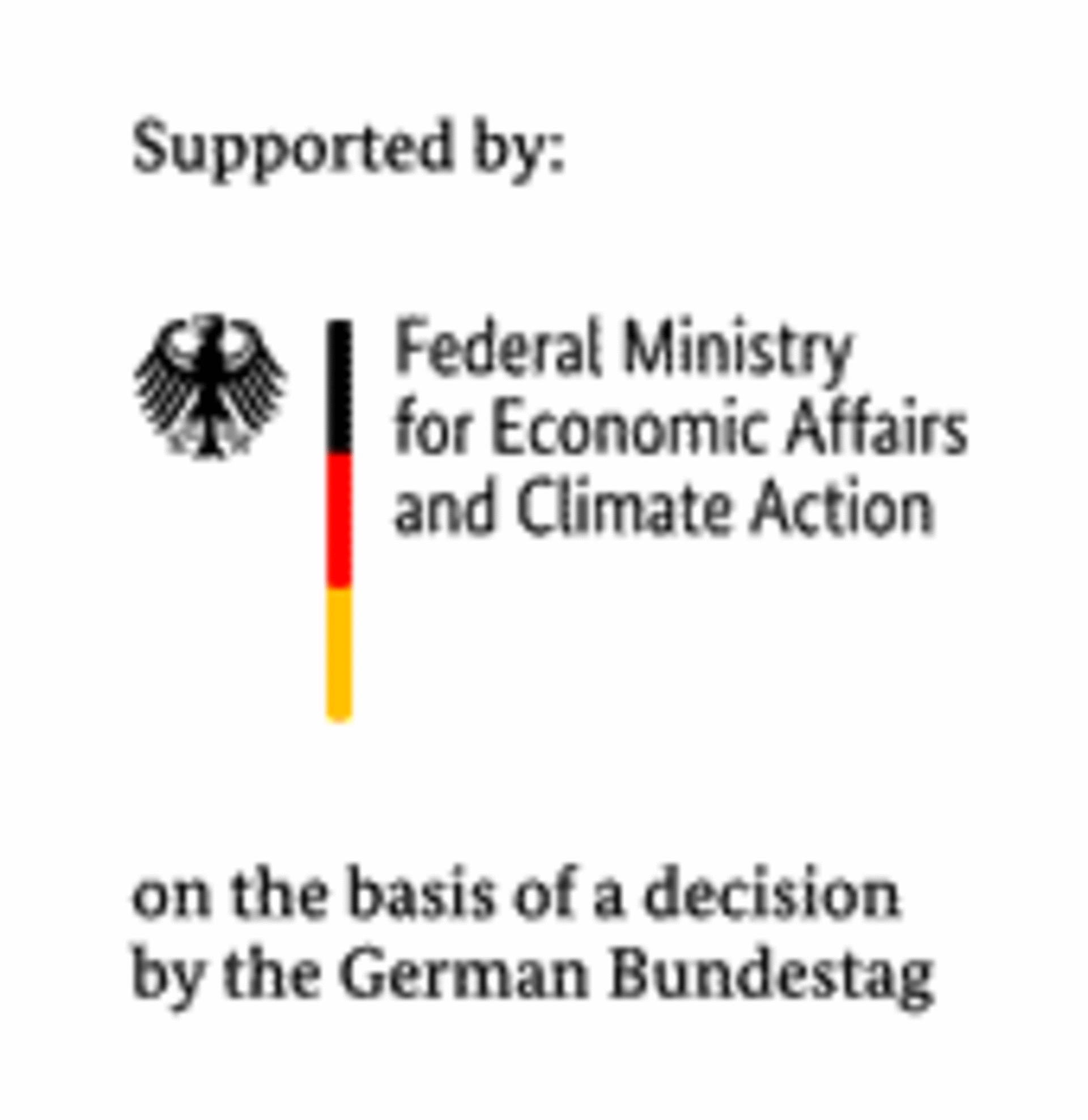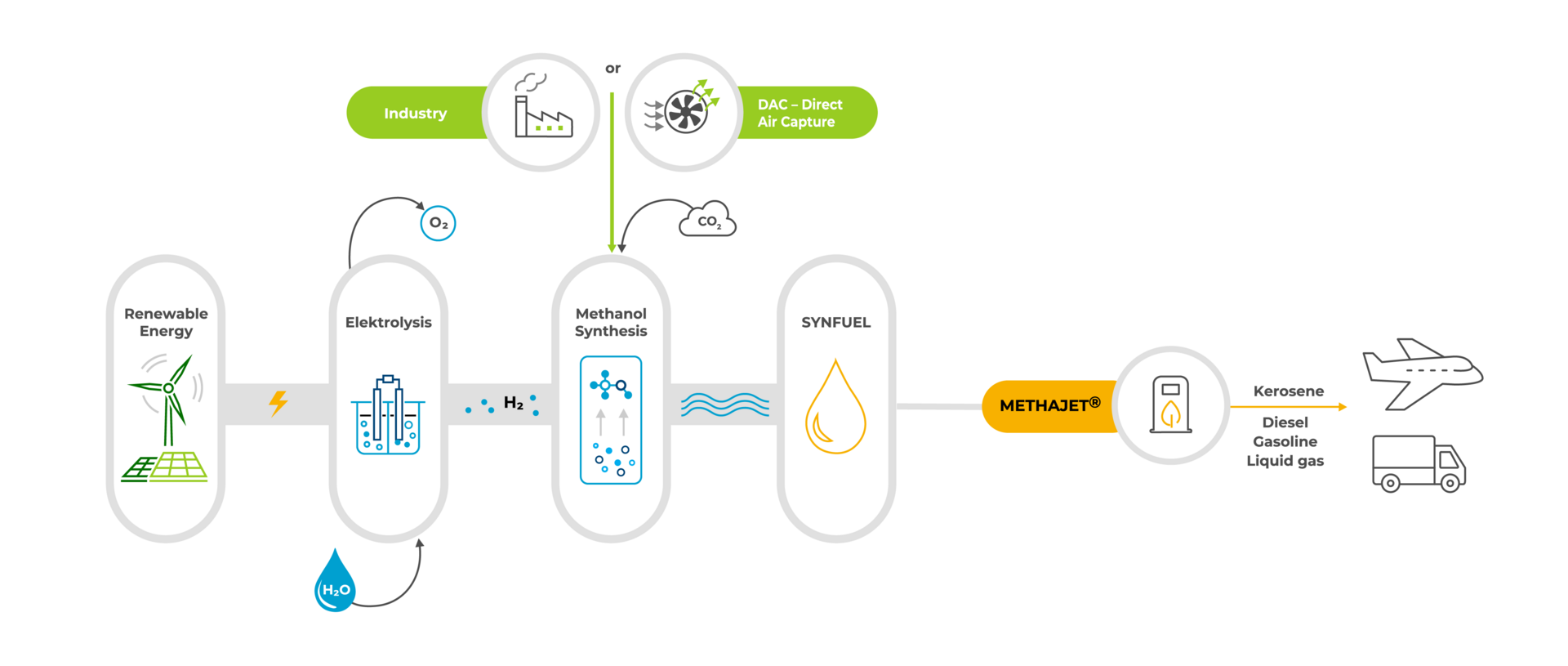
CAC METHAJET® –
a new, unique method of manufacturing
Unlike road traffic, air traffic cannot be electrified that easily. In order to achieve a significant reduction in CO2 emissions in this sector, renewable fuels such as e-kerosene, also called Sustainable Aviation Fuels (SAF), are indispensable. Chemically, they are almost identical to the kerosene produced on a fossil basis, but they have a significantly lower CO2 footprint. Our own CAC METHAJET® technology is subdivided into the process stages of MtO (Methanol-to-Olefins), OtJ (Olefins-to-Jet fuel) and hydrofinishing. In addition to the finished primary product, kerosene, other co-products and by-products are produced:
diesel, gasoline, liquid gas and water.
In order to steer this technology to market readiness, the production of e-kerosene from renewable methanol is being further developed in the current EwOPro research project (development of Olefins-to-Jetfuel processes). It is supported by the Federal Ministry for Economic Affairs and Climate Action.
For this purpose, in cooperation with our long-standing partner, Freiberg University of Mining and Technology (TU Bergakademie Freiberg), we have developed a process chain on a pilot plant scale. The goal is to produce synthetic kerosene from renewable methanol, in order to provide it to the project partners for, among other things, fuel and aircraft turbine tests, to use the data for further development of the technology and to design industrial production plants as well as to have the METHAJET® technology certified in accordance with the applicable ASTM (American Society for Testing and Materials) standard.

Not only
CO2 benefits!
Sustainable fuels have the advantage that no cyclic hydrocarbons, so-called aromatics, are used for their production. Less aromatics in the fuel means that emissions contain less soot particles. Soot particles act as the nucleus for formation of ice crystals in condensation trails. Therefore, reducing the soot content in emissions of aircraft engines helps to minimize ice crystals in contrails.
This, in turn, reduces the contribution of contrails to climate change. Contrails persist in the sky only for a few hours, forming high clouds known as cirrus clouds. If they contain less ice crystals, their warming effect quickly diminishes.
For this reason, the use of sustainable aviation fuels for flight paths on which contrails frequently occur is a particularly effective way of making a quick and targeted contribution to climate protection.
Our objective: Net zero carbon in aviation by 2050!
The increasing global level of mobility has led to a significant rise in cargo and passenger flights in the course of the past decades. According to various development forecasts, this trend and the associated demand for kerosene are set to continue, in spite of numerous approaches to achieve technical and operational optimization.
Sustainable aviation fuel (SAF) from renewable energy sources is the key to moving aviation responsibly into a low-CO2 future. In doing so, the use of SAF helps to significantly reduce dependency on fossil aviation fuel. CO2, water and electricity are used to produce methanol, which is converted into sustainable kerosene using CAC’s Methanol-to-Jet fuel technology. In this connection, the process enables the provision of SAF and contributes to the fulfillment of European Climate Law.
Openness to all technologies as a recipe for success
Our research has shown that technical innovations are crucial to reducing CO2 emissions despite rising flight volumes. According to legals regulations, aviation fuel must contain at least 0.5 % of power-to-liquid kerosene by the year 2026. By 2030, this share is even set to rise to 2%. This equals to an amount of 200,000 tons per years.
As you can see, the demand in synthetic kerosene exists, but the challenge is to meet this demand. In our demonstration plant in Heide we show how the industrial production of e-kerosene can be successfully implemented.
Power to Liquid (PtL) means the production of fuel from electricity.
This process helps to store electricity generated from renewable sources and distribute it worldwide with the aid of the existing infrastructure. Especially those sectors that rely on liquid fuel, such as aviation, can become CO2-neutral through this process.
SAF stands for Sustainable Aviation Fuel and is the generic term for aviation fuels created from sustainable feedstock without the use of fossil fuels. During the production of SAFs, CO2 is absorbed from the atmosphere, which has a beneficial effect on the overall carbon emissions.
E-kerosene could be used immediately in aviation. It can be used with current airplanes and turbines without hesitation. CAC is currently working on the market launch. In this respect, the large-scale demonstration plant at the Heide refinery in Schleswig-Holstein represents the next step on the road to market maturity.
Unlike cars and trucks, airplanes cannot be battery-powered in the future and will continue to rely on liquid fuels. It is therefore important to create a way to produce kerosene in a sustainable and environmentally friendly way. In this connection, CAC and its partners from research and industry, has developed a process that converts green electricity, water and CO2 into e-kerosene in three stages.
E-kerosene is an important component in achieving our 2030 and 2050 climate goals. A CO2-neutral fuel is needed to reduce emissions in aviation. The e-kerosene developed by CAC can lead aviation into a low-CO2 future.
Yes, the production of e-kerosene can also be realized on a larger scale. To this end, CAC is currently commissioning a large-scale demonstration plant in Heide, Schleswig-Holstein. In the long term, the generation of sufficient energy from renewable resources will be the crucial issue in SAF production.





